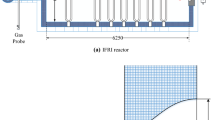Abstract
Computational fluid dynamics is becoming an important tool in the study of chemical engineering processes and apparatuses (in particular, the share of works with the application of this method is nearly 6% of the total number of all chemical engineering works issued by Elsevier Science Publishers in 2010). The possibilities of computational fluid dynamics are demonstrated using examples from three different chemical engineering fields: developing a method for loading a tubular reactor for the steam conversion of natural gas, studying heat transfer in a reactor for the hydrogenation of vegetable oils upon the replacement of a catalyst, and investigating the transitional processes in an automobile neutralizer. The results from computational fluid dynamics are verified by comparing them with experimental data in developing a method for loading a tubular reactor, using the problem of decelerating a catalyst particle with a flow of air as an example. The obtained data are compared with classical measurement data on the aerodynamic drag of a ball and a cylinder and represent the further development of works on the flow around particles of complex shape. In this work, the results from inspecting a reactor for the hydrogenation of oils with allowance for the possible heating and uniform distribution of a flow before its entering the catalyst bed are presented. It is shown that the construction of the reactor does not ensure homogeneity of the reaction flow at the desired level and requires modification of heating elements. The efficiency of computational fluid dynamics for investigating fast processes with a chemical reaction is exemplified by studying the transitional processes in an catalytic automobile neutralizer (the effect of flow dynamics and heat transfer on the thermal regime in a honeycomb catalyst particle is very difficult to study by experimental methods). The application of computational fluid dynamics allows us to reduce considerably the time and cost of developing and optimizing the designs of efficient catalytic fixed-, fluidized-, or moving-bed reactors (particularly multiphase stirred (slurry) reactors), along with mixers, adsorbers, bubblers, and other chemical engineering apparatuses with moving media.
Similar content being viewed by others
References
Fluent 6.1 User’s Guide, Lebanon, NH: Fluent Inc., 2003.
RF Patent 2180265, 2001.
Klenov, O.P., Khanaev, V.M., Borisova, E.S., Sviridonov, A.A., et al., Katal. Prom-sti, 2008, Suppl., p. 38.
Schlichting, H., Boundary Layer Theory, New York: McGraw-Hill, 1974.
Deich, M.E., Tekhnicheskaya gazodinamika (Technical Gas Dynamics), Moscow: Energiya, 1974.
Author information
Authors and Affiliations
Additional information
Original Russian Text © O.P. Klenov, A.S. Noskov, 2011, published in Kataliz v Promyshlennosti.
Rights and permissions
About this article
Cite this article
Klenov, O.P., Noskov, A.S. Computational fluid dynamics in the development of catalytic reactors. Catal. Ind. 3, 331–349 (2011). https://doi.org/10.1134/S2070050411040039
Published:
Issue Date:
DOI: https://doi.org/10.1134/S2070050411040039




